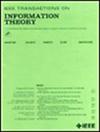Deterministic Identification Over Channels With Finite Output: A Dimensional Perspective on Superlinear Rates
IF 2.2
3区 计算机科学
Q3 COMPUTER SCIENCE, INFORMATION SYSTEMS
引用次数: 0
Abstract
Following initial work by JaJa, Ahlswede and Cai, and inspired by a recent renewed surge in interest in deterministic identification (DI) via noisy channels, we consider the problem in its generality for memoryless channels with finite output, but arbitrary input alphabets. Such a channel is essentially given by its output distributions as a subset in the probability simplex. Our main findings are that the maximum length of messages thus identifiable scales superlinearly as有限输出信道上的确定性辨识:超线性速率的维度视角
在JaJa, Ahlswede和Cai的初步工作之后,并受到最近对通过噪声通道的确定性识别(DI)的兴趣重新高涨的启发,我们考虑了具有有限输出但任意输入字母的无记忆通道的一般性问题。这样的信道本质上是由它的输出分布作为概率单纯形的子集给出的。我们的主要发现是,因此可识别的消息的最大长度超线性缩放为$R\,n\log n$,块长度为n,并且最佳速率R根据输出集的某个代数变换的覆盖(又名Minkowski,或Kolmogorov,或熵)维d有界:$\frac {1}{4} d \leq R \leq \frac {1}{2} d$。值得注意的是,上下闵可夫斯基维度都在这一结果中发挥了作用。在此过程中,我们提出了一个假设检验引理,表明它足以确保输出分布的成对可靠区分来构建DI代码。虽然我们不知道确切的容量公式,但我们可以得出结论,DI容量表现出超激活:存在单个容量为零的通道,但其乘积具有正容量。我们还将这些结果推广到具有有限维输出量子系统的经典量子通道,特别是在识别码只能使用张量积输入的约束下的有限维量子系统上的量子通道。
本文章由计算机程序翻译,如有差异,请以英文原文为准。
求助全文
约1分钟内获得全文
求助全文
来源期刊

IEEE Transactions on Information Theory
工程技术-工程:电子与电气
CiteScore
5.70
自引率
20.00%
发文量
514
审稿时长
12 months
期刊介绍:
The IEEE Transactions on Information Theory is a journal that publishes theoretical and experimental papers concerned with the transmission, processing, and utilization of information. The boundaries of acceptable subject matter are intentionally not sharply delimited. Rather, it is hoped that as the focus of research activity changes, a flexible policy will permit this Transactions to follow suit. Current appropriate topics are best reflected by recent Tables of Contents; they are summarized in the titles of editorial areas that appear on the inside front cover.
 求助内容:
求助内容: 应助结果提醒方式:
应助结果提醒方式:


